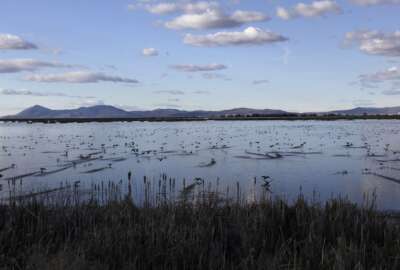New Interior Department rule expands an old one by thousands of miles
For many years, the Interior Department has used a simple procedure to do assessments of environmental damage. It concerns hazardous materials released to the Great...
For many years, the Interior Department has used a simple procedure to do assessments of environmental damage. It concerns hazardous materials released to the Great Lakes and a few other coastal locations. Now Interior proposes to greatly expand the size of the cases covered by the simple procedure, and to apply it everywhere. For more, the Federal Drive with Tom Temin spoke with Attorney Brian Ferrasci- O’Malley of the Nossaman law firm.
Interview Transcript:
Tom Temin This is kind of an arcane thing, but since the Interior Department wants to do it everywhere, there’s the environment in the country, which is everywhere. I guess we ought to know what it is they’re planning to do here. Tell us about the rule and how it works now.
Brian Ferrasci- O’Malley Absolutely, Tom. So what we’re talking about here are natural resource damage assessments and restoration, or NRDAR. And this is a process by which government agencies that federal trustees assess and restore natural resources that are injured as a result, like you said, of hazardous substances or oil getting into the environment and damaging the public resources. So the trustees, the government agencies assess what was the damage. They work with potentially responsible parties in industry, whoever caused the damage to recoup funds for that. And then they go out and conduct restoration. And as you noted, type A, the type A rule is what we’re talking about here. There are two different ways that the government goes about assessing what happened, what were the damages, and who do we need to go after. And this type A rule, that proposed rule was released about two weeks ago now back on Jan. 5 and a comment period open until March 5. It’s a way of saying, how can we have a simplified process to get from, there was a spill to putting restoration on the ground. There are these two, the type A and the type B. Type B is very case specific. It’s very complicated, takes a long time. You go and do a bunch of studies. Type A has always been meant to be the simplified version, but it hasn’t been used in maybe even decades because of how outdated the rule and the models were. So that’s what the government’s trying to do.
Tom Temin And the earlier type A was for relatively small cases, I think $100,000 or less. Now they want it to be up to 5 million.
Brian Ferrasci- O’Malley Yes. So the way that type A was initially meant to be was very narrow. So like you said, only cases for $100,000 or less of damages, which as an aside, Tom, is basically no NRD cases anymore. The smallest case that really gets moved through, maybe you’re talking about 400 and $500,000 in damages. And you mentioned in the lead it was only really applicable to two areas, the Great Lakes and then coastal and marine environments. And you had to use this model that was actually written into the regulations. All the inputs were there. So that was 1997. We were still using floppy disks at the time and the government to run these models. And my understanding is the government can’t even, we don’t have the computers anymore that are working to run the particular model. So they are expanding. Who can use type A, but I would think of that as just shifting some things over from type B. So if you had a case that was, say, $1 million damages, even if you could theoretically model it and do it real quick, you didn’t have the opportunity, you couldn’t use that type A rule. You had to go the type B site specific, take a long time, do a bunch of studies way. So that’s where I think the government is trying to go and interior with opening type A up.
Tom Temin So this would apply to say someone, say a tanker truck full of heavy crude oil or something, or some terrible chemicals dumps over and pollutes a local lake somewhere. This would apply because it’s only a truckload, but it would not apply, say, to what happened in East Palestine, where there could be hundreds of millions of dollars worth of damage they don’t even know yet. I think it’s still smoldering over there.
Brian Ferrasci- O’Malley Definitely. This is meant for cases, even with the new proposed cap of up to $3 million generally, or $5 million for certain discrete releases, it’s 5 million for a case like you mentioned, like East Palestine, some larger spill or release of chemicals is a lot. So you are going to be able to use this on more, maybe we say run of the mill cases, not the ones that are going to the East Palestine, the Exxon Valdez, the Deepwater Horizon oil spill. Those things are still going to go through the type B site specific process.
Tom Temin We’re speaking with Brian Ferrasci-O’Malley. He’s a partner at the law firm Nossaman. And basically is the type A design for rapid settlement, that is to avoid going to court and having expensive studies done by both. I guess, it’s expensive for the parties involved, the spiller, but also the government wants to settle it fast too, I imagine.
Brian Ferrasci- O’Malley You make some good points. I’m smiling because rapid is an interesting term for the way that the government works sometimes, Tom, I know you know this. It is meant to be a more streamlined, more efficient way because, as you noted, the longer these take from the industry side, that cost more money, more time until you get finality on your project. But it’s the same issues that plague the government here. The longer it takes to do a project to go through and recoup what the public lost, the fewer cases you can do, the more time you’re spent on the administrative side, the less time resources are out there not being restored to their baseline, so it should provide a way. I don’t think it will be rapid, but it should be faster than it currently is, because these cases can take years, Tom, and do take years. And so if you can move from decades to just years, that’s beneficial on both sides of the equation.
Tom Temin And you mentioned there’s a algorithm or some kind of a model that runs such that you can apply the inputs from what you’ve measured or what you’ve seen on a given site. Run it through this program and it’ll give some kind of a settlement figure. I’m probably oversimplifying. So were you saying there the algorithm itself is probably out of date, and it was developed in a way that it’s not useful in modern systems.
Brian Ferrasci- O’Malley Absolutely, Tom. The current type A that’s out there in the regulations right now, last revised in 1997, is a static equation. It’s written into the regulations. You must use that particular equation, and you can’t deviate from it. We have learned plenty in the last 30 odd years of NRD cases. You can’t use any of that knowledge. You have to use the old model. So the new rule takes away that model and basically says, all right, we’re going to use models that are well-accepted in the industry. It gives some examples things called a habitat equivalency analysis, HEA, or resource equivalency analysis, REA. Their models that have been developed over decades now that help estimate the damages rather than having to go out and do all of the individual studies. So models like that, the new rule is saying you can use those since we understand them and we have a lot of experience or potentially open up for other models in the future that we can develop. And that’s a key benefit, I think, of the proposed rule is this idea that it will be flexible, it will be able to be something that we’re not going to be fixed in time in 2024 and have to do this again in ten years when the rule doesn’t make any sense anymore. But yeah, it’s meant to help find a way to use models to get to that answer quicker.
Tom Temin And do the modern models have some flexibility? That is to say, if something, I keep using the spill example, but that’s usually what happens if the spill is in a remote area that affects just a small contained water body versus the same amount of spill of the same material, but in a place where there’s a public water supply, lots of homes nearby, or whatever, that type of thing, the modern models can take into account those variables to arrive at what a settlement might be worth.
Brian Ferrasci- O’Malley Yeah, Tom, there are a lot of smart economists at interior who have spent a lot of time developing these type of models. And I think as a lawyer and a recovering scientist, what I would say is that the more details, the more different variables you have to add in, the harder it gets to make the model work perfectly. And that’s why these are made for more cases where it’s, again, I don’t want to say run of the mill, because these are all instances where something bad happens and it does impact the public. But you’re operating in a sense where, all right, we generally understand. If it’s this type of spill, we’ve done a bunch of these types of spills. We have a clear understanding of the variables and what’s going on. We can use those models quickly and easily to process something.
Tom Temin Well, in your estimation, is industry going to say, oh my God, this is the worst thing ever to come along? Or are they likely to comment, yes, but maybe tweak it here and there.
Brian Ferrasci- O’Malley I think it’s the latter. I think industry has been asking for a long time for interior to come up with ways to clarify and speed up the process. There are many opportunities where you sit there from the industry perspective and you say, I think we understand what’s going on here, let’s move on. We want to be done and you want to get restoration on the ground.
Copyright © 2024 Federal News Network. All rights reserved. This website is not intended for users located within the European Economic Area.
Tom Temin is host of the Federal Drive and has been providing insight on federal technology and management issues for more than 30 years.
Follow @tteminWFED






